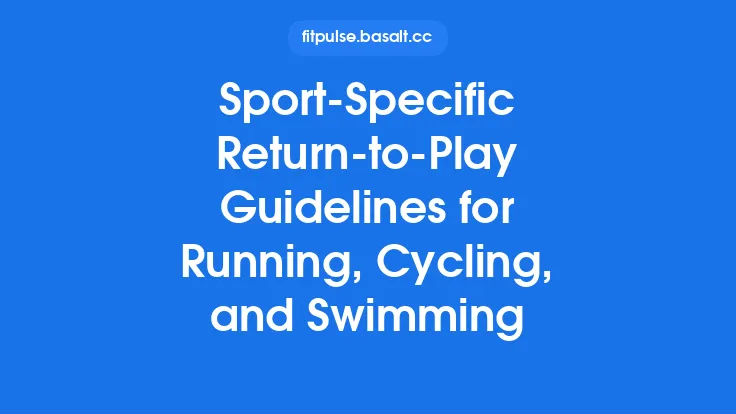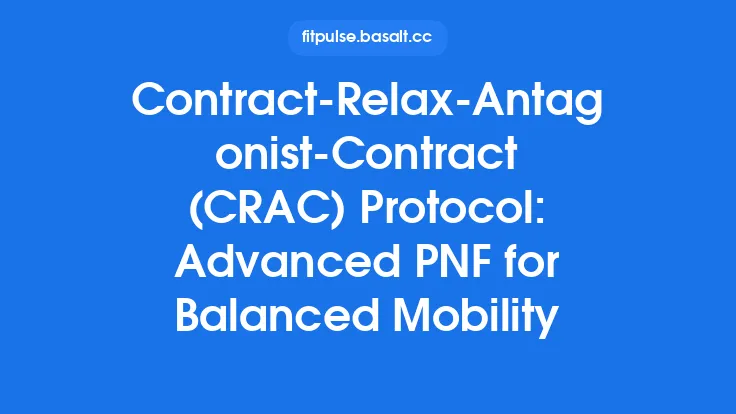Recovering from a sports injury is rarely a linear journey, but having a clear, step‑by‑step roadmap can turn uncertainty into confidence. Below is a comprehensive, evergreen protocol that guides athletes—from the moment pain first spikes to the point where they step back onto the field, court, or track—through the essential stages of healing, conditioning, and performance restoration. While the steps are universal, each can be fine‑tuned to the specific tissue involved (ankle, knee, hamstring, shoulder, etc.) and the demands of the sport.
Understanding the Phases of Recovery
A successful return‑to‑play (RTP) plan is built on four overlapping phases:
- Acute Management – Controlling pain, swelling, and protecting the injured structure.
- Restorative Rehabilitation – Restoring range of motion (ROM), basic strength, and neuromuscular control.
- Functional Conditioning – Translating restored tissue capacity into sport‑specific movement patterns.
- Performance Integration – Re‑exposing the athlete to full‑speed, competitive scenarios while maintaining the gains achieved.
Each phase has distinct objectives, typical timelines, and concrete actions. Progression is dictated by the athlete’s response, not by a preset calendar.
Initial Assessment and Immediate Care
- Rapid Clinical Evaluation – Within the first 24–48 hours, a qualified clinician should confirm the injury’s nature (e.g., sprain, strain, contusion, partial tear).
- Imaging When Indicated – Plain radiographs for suspected fractures, ultrasound for superficial soft‑tissue lesions, and MRI for deeper or complex injuries.
- Pain‑Swelling‑Function Triage – Classify the injury as mild, moderate, or severe based on pain intensity, swelling volume, and functional limitation. This triage informs the length of the acute phase.
- Education & Goal Setting – Explain the expected timeline, outline the step‑by‑step plan, and set realistic short‑term milestones (e.g., “walk without limp in 5 days”).
Phase 1: Managing Inflammation and Restoring Mobility
Goal: Reduce tissue irritation while preventing stiffness.
| Action | Details |
|---|---|
| Cryotherapy | Apply ice packs (15 min on, 45 min off) for the first 48–72 hours, then transition to contrast therapy if tolerated. |
| Compression & Elevation | Use elastic bandages or pneumatic sleeves; elevate the limb above heart level to aid venous return. |
| Protected Weight‑Bearing | For lower‑extremity injuries, employ crutches or a partial‑weight‑bearing boot as directed. |
| Gentle Passive ROM | Initiate pain‑free passive movements (e.g., ankle dorsiflexion/plantarflexion, shoulder pendulum swings) 2–3 times daily to maintain joint nutrition. |
| Isometric Activation | Begin low‑intensity isometrics (e.g., quadriceps sets, gluteal squeezes) to preserve neuromuscular firing without stressing the injured tissue. |
| Modalities | Consider low‑level laser therapy or therapeutic ultrasound if clinically indicated. |
Typical duration: 3–7 days for mild injuries; up to 10–14 days for moderate lesions.
Phase 2: Building Strength and Stability
Goal: Re‑establish muscular force production and joint stability without provoking inflammation.
| Step | Exercise | Progression Criteria |
|---|---|---|
| Closed‑Chain Strength | Body‑weight squats, lunges, step‑ups (for knee/ankle); push‑ups, wall slides (for shoulder). | Ability to complete 2 sets of 12 reps with < 2 % pain increase. |
| Dynamic Stability Drills | Single‑leg balance on stable surface → unstable surface (BOSU, foam pad). | Maintain balance for 30 seconds with minimal sway. |
| Eccentric Loading | Nordic hamstring curls, slow lowering squats, eccentric calf raises. | No surge in soreness beyond mild delayed onset muscle soreness (DOMS). |
| Core Integration | Planks, dead‑bugs, bird‑dogs. | Hold for 45 seconds with neutral spine. |
| Proprioceptive Circuit | Ladder drills, mini‑hops, lateral shuffles. | Perform 3 rounds without compensatory movements. |
Typical duration: 2–4 weeks, depending on tissue healing and strength gains.
Phase 3: Reintroducing Functional Movements
Goal: Bridge the gap between isolated strength work and sport‑specific motor patterns.
- Movement Pattern Re‑education – Practice the fundamental movement chain of the sport (e.g., squat‑to‑jump for basketball, hip‑hinge‑to‑drive for rowing).
- Speed‑Controlled Drills – Execute the movement at 40‑60 % of maximal speed, emphasizing technique and joint alignment.
- Load Increment – Add external resistance (light kettlebells, medicine balls) while preserving form.
- Multiplanar Work – Incorporate rotational and diagonal patterns to mimic real‑world demands (e.g., cable woodchops for tennis).
- Endurance Component – Perform the functional circuit for 10–15 minutes to assess fatigue resistance.
Typical duration: 1–2 weeks. The athlete should complete the functional circuit without pain, swelling, or loss of coordination.
Phase 4: Simulated Sport Scenarios
Goal: Test the athlete’s ability to execute sport‑specific actions under realistic conditions.
| Scenario | Example Activities |
|---|---|
| Agility & Change‑of‑Direction | T‑drill, Illinois agility test, cone shuffles at 70‑80 % effort. |
| Contact Simulation (if applicable) | Light pad work, controlled tackling drills, or partner resistance. |
| Skill Execution | Shooting drills (soccer), serve practice (volleyball), swing drills (golf) at sub‑maximal intensity. |
| Partial Competition | Participate in a controlled scrimmage or practice set lasting 15–20 minutes. |
Progression is based on the athlete’s ability to maintain technique, avoid pain spikes, and demonstrate consistent performance across repetitions.
Typical duration: 1–2 weeks, with daily monitoring for any adverse response.
Phase 5: Full Competition Readiness
Goal: Confirm that the athlete can sustain full‑intensity play for the duration of a typical competition.
- Full‑Speed, Full‑Duration Sessions – Engage in a complete practice or match simulation matching the sport’s typical length (e.g., 90‑minute soccer game, 4‑quarter basketball).
- Recovery Observation – Track post‑session soreness and swelling; a mild, transient increase is acceptable, but persistent pain is not.
- Final Clearance – A qualified clinician signs off, confirming that the injury has healed structurally and functionally.
At this stage, the athlete should feel confident in their physical capacity, and objective signs (ROM, strength symmetry, movement quality) should be within 90‑95 % of the uninjured side.
Tailoring the Protocol to Specific Injuries
| Injury | Key Modifications |
|---|---|
| Ankle Sprain (Grade I‑II) | Emphasize early proprioceptive work; progress to single‑leg hops by week 3. |
| Hamstring Strain (Grade II) | Prioritize eccentric hamstring loading; delay high‑speed running until week 4. |
| Shoulder Impingement | Incorporate scapular stabilization drills early; avoid overhead loading until pain‑free ROM is restored. |
| Patellar Tendinopathy | Use heavy‑slow resistance (HSR) quadriceps training; limit plyometrics until tendon load tolerance improves. |
| Meniscal Tear (Conservative Management) | Focus on closed‑chain knee control; avoid deep squats and pivoting until week 6–8. |
| Achilles Tendonitis | Begin with eccentric calf raises on a step; progress to single‑leg hops only after 2 weeks of pain‑free loading. |
Each injury’s biological healing timeline informs when to introduce the next phase, but the step‑by‑step framework remains consistent.
Monitoring and Adjusting the Plan
Even though detailed “monitoring metrics” are covered elsewhere, a brief, practical checklist ensures the protocol stays on track:
- Pain Check – Ask the athlete to rate pain on a 0‑10 scale before and after each session. A rise of > 2 points warrants a step back.
- Swelling Observation – Visual inspection and gentle palpation; any increase signals a need for additional anti‑inflammatory measures.
- Movement Quality – Use a simple “technique rating” (good, fair, poor) for each drill; downgrade intensity if quality drops.
- Fatigue Response – Note if the athlete’s performance deteriorates markedly after the first half of a session; consider extending the conditioning phase.
Adjustments are made in real time, ensuring the athlete never exceeds the tissue’s current tolerance.
Key Takeaways
- A structured, phase‑based approach transforms a vague “return when you feel ready” mindset into a measurable, repeatable process.
- Early control of inflammation, followed by progressive strength, functional movement, and sport simulation, creates a solid foundation for safe RTP.
- Customization for the specific injury and sport ensures relevance while preserving the universal step‑by‑step logic.
- Continuous, simple monitoring (pain, swelling, technique) allows timely modifications without the need for complex metrics.
By adhering to this step‑by‑step protocol, athletes can confidently navigate the road from injury back to competition, minimizing setbacks and maximizing long‑term performance.





